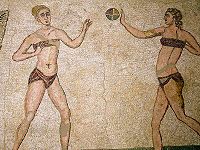Greek & Roman Mosaic
Greek and Roman Mosaics of the 4th century BC which are found in the Macedonian palace-city of Aegae, & the 4th-century BC mosaic of The Beauty of Durrës discovered in Durrës, Albania in 1916, are early figural examples; the Greek figural style was mostly formed in the 3rd century BC. Mythological subjects, or scenes of hunting or other pursuits of the wealthy, were popular as the centrepieces of a larger geometric design, with strongly emphasized borders.[citation needed] Pliny the Elder mentions the artist Sosus of Pergamon by name, describing his mosaics of the food left on a floor after a feast and of a group of doves drinking from a bowl.[2] Both of these themes were widely copied.[3] Greek figural mosaics probably copied or adapted paintings, a far more prestigious artform, and the style was enthusiastically adopted by the Romans so that large floor mosaics enriched the floors of Hellenistic villas, and Roman dwellings from Britain to Dura-Europos. Most recorded names of Roman mosaic workers are Greek, suggesting they dominated high quality work across the empire; no doubt most ordinary craftsmen were slaves. Splendid mosaic floors are found in Roman villas across North Africa, in places such as Carthage, and can still be seen in the extensive collection in Bardo Museum in Tunis, Tunisia. There were two main techniques in Greco-Roman mosaic: opus vermiculatum used tiny tesserae, typically cubes of 4 millimeters or less, and was produced in workshops in relatively small panels which were transported to the site glued to some temporary support. The tiny tesserae allowed very fine detail, and an approach to the illusionism of painting. Often small panels called emblemata were inserted into walls or as the highlights of larger floor-mosaics in coarser work. The normal technique was opus tessellatum, using larger tesserae, which was laid on site. There was a distinct native Italian style using black on a white background, which was no doubt cheaper than fully coloured work (see the dog at left). In Rome, Nero and his architects used mosaics to cover some surfaces of walls and ceilings in the Domus Aurea, built 64 AD, and wall mosaics are also found at Pompeii and neighbouring sites. However it seems that it was not until the Christian era that figural wall mosaics became a major form of artistic expression. The Roman church of Santa Costanza, which served as a mausoleum for one or more of the Imperial family, has both religious mosaic and decorative secular ceiling mosaics on a round vault, which probably represent the style of contemporary palace decoration. The mosaics of the Villa Romana del Casale near Piazza Armerina in Sicily are the largest collection of late Roman mosaics in situ in the world, and are protected as a UNESCO World Heritage Site. The large villa rustica, which was probably owned by Emperor Maximian, was built largely in the early 4th century. The mosaics were covered and protected for 700 years by a landslide that occurred in the 12th century. The most important pieces are the Circus Scene, the 64 m long Great Hunting Scene, the Little Hunt, the Labours of Hercules and the famous Bikini Girls, showing women exercising in modern-looking bikinis. The peristyle, the imperial apartments and the thermae were also decorated with ornamental and mythological mosaics. Other important examples of Roman mosaic art in Sicily were unearthed on the Piazza Vittoria in Palermo where two houses were discovered. The most important scenes there depicted Orpheus, Alexander the Great's Hunt and the Four Seasons.
In 1913, Zliten mosaic, a Roman mosaic, famous for its many scenes from gladiatorial contests, hunting and everyday life was discovered in the Libyan town of Zliten. In 2000 archaeologists working in Leptis Magna, Libya uncovered a 30 ft length of five colorful mosaics created during the 1st or 2nd century AD. The mosaics show a warrior in combat with a deer, four young men wrestling a wild bull to the ground, and a gladiator resting in a state of fatigue, staring at his slain opponent. The mosaics decorated the walls of a cold plunge pool in a bath house within a Roman villa. The gladiator mosaic is noted by scholars as one of the finest examples of mosaic art ever seen — a "masterpiece comparable in quality with the Alexander Mosaic in Pompeii." Beautiful and impressive are also the recent findings in Zeugma.[4]


